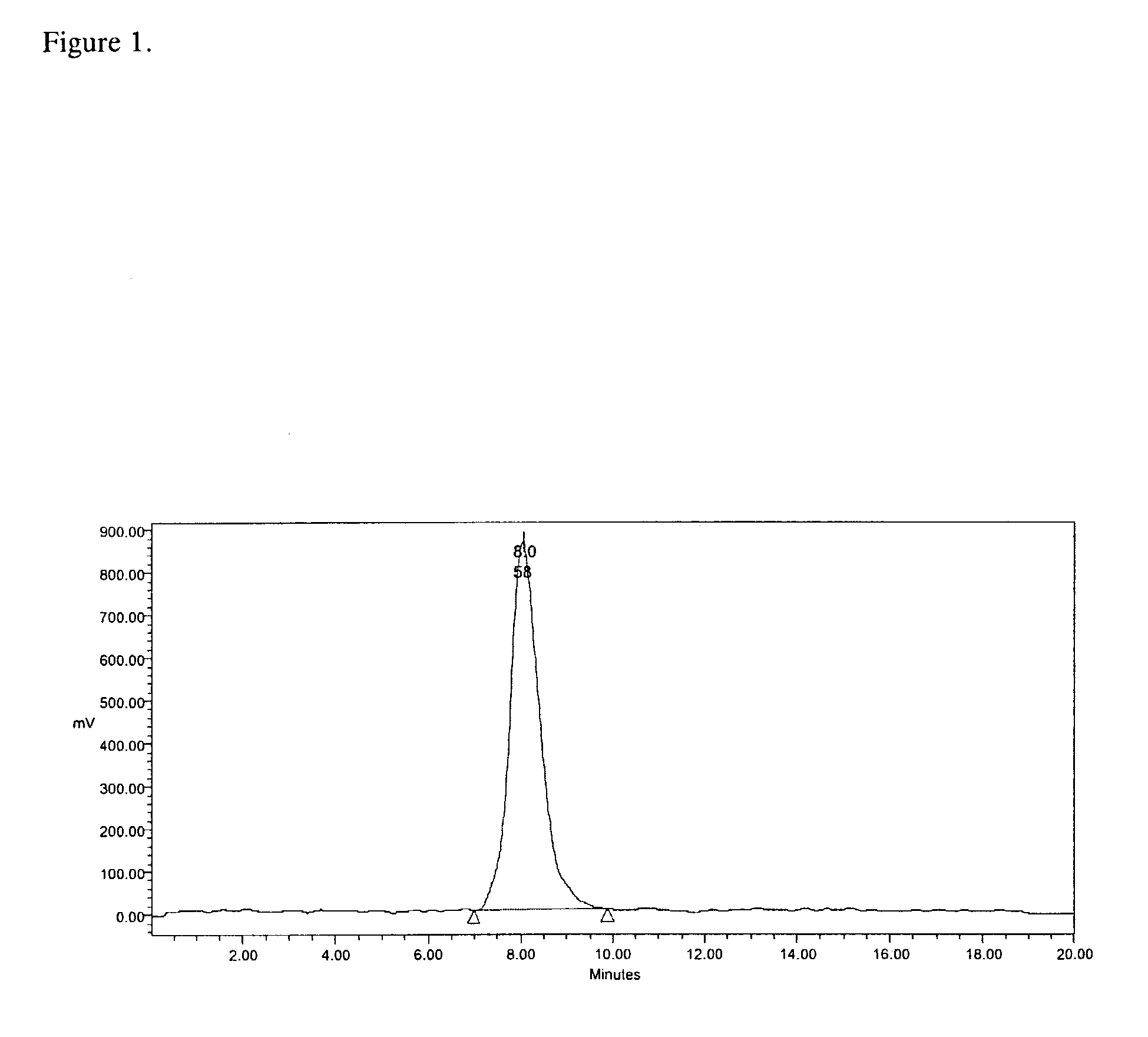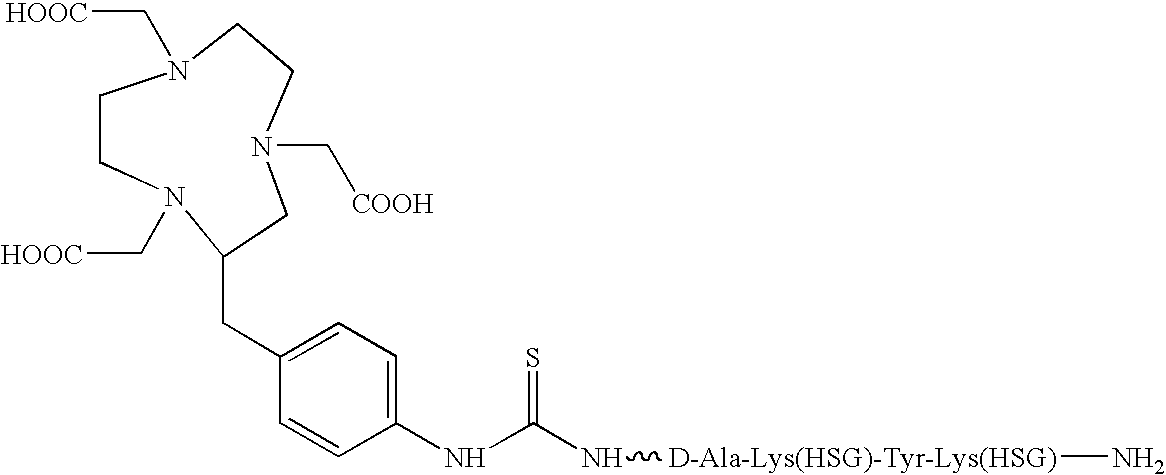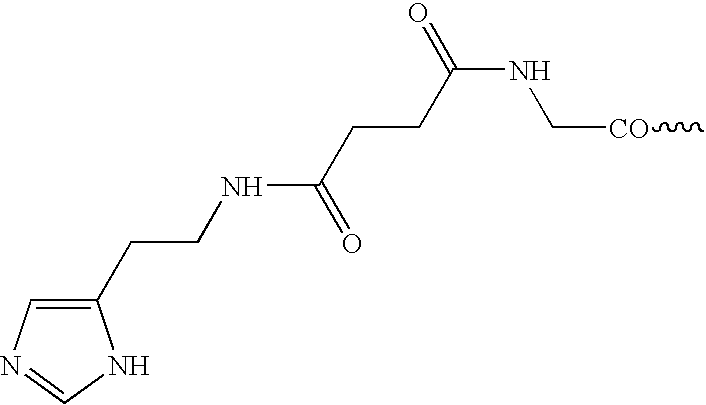Labeling targeting agents with gallium-68 and gallium-67
a technology of gallium-68 and targeting agents, which is applied in the field of labeling targeting agents, can solve the problems of hampered development of pet into a routinely applied clinical diagnostic modality, limited sensitivity of these detection modalities, and difficult detection of tumor nodules less than 1 centimeter diameter, etc., and achieves improved treatment options, fast, safe, and accurate detection
- Summary
- Abstract
- Description
- Claims
- Application Information
AI Technical Summary
Benefits of technology
Problems solved by technology
Method used
Image
Examples
example 1
Acid Elution of a Ge-68 / Ga-68 Generator
[0034]A Ge-68 / Ga-68 generator is placed inside a half-inch lead ‘molycoddle’ for extra shielding, and this is further surrounded by a 2-inch thick lead wall. The inlet of the generator is fitted with sterile tubing and a 3-way stopcock. The two other ports of the stopcock are attached to a 10-mL sterile syringe and a source of ultra-pure 0.5 N hydrochloric acid, respectively. The outlet port of the generator is fitted with sterile tubing and a QF5 anion exchange membrane that had been previously washed with 0.5 N hydrochloric acid. By means of the inlet syringe, a 5-mL portion of the 0.5 N hydrochloric acid is withdrawn from the stock solution, the stopcock is switched to allow access to the generator column, and the acid is hand-pushed through the generator. The eluate containing the Ga-68 is collected in a lead-shielded acid-washed vial optionally already containing the NOTA-containing targeting agent to be Ga-68 radiolabeled.
example 2
Ga-68 Labeling of IMP 244 Peptide Using the Above Elution Technique
[0035]A 5×10−8 portion of the NOTA-containing peptide IMP 244 is mixed with 2 mL of 4M metal-free ammonium acetate buffer, pH 7.2, in an acid-washed vial. The Ga-68 ingrowth from the generator, 5 mCi, is eluted dire the techniques described in the previous example. After brief mixing, the vial contents are heated 30 minutes at 45° C. The incorporation of Ga-68 into the IMP 244 is measured at 94%, after the 30-minute labeling time, by size-exclusion high-performance liquid chromatography (SE-HPLC) on a Bio-Sil 250 column run in 0.2 M phosphate buffer, pH 6.8, with column recovery determined, and detection by in-line Radiomatic detection using energy windows set for Ga-68. Corroborative data is obtained using instant thin-layer chromatography (ITLC) using silica gel-impregnated glass fiber strips (Gelman Sciences, Ann Arbor, Mich.), developed in a 5:3:1 mixture of pyridine, acetic acid and water.
example 3
Ga-68-IMP 244 and anti-HSG MAb Complex Formation
[0036]An aliquot of the Ga-68-IMP 244 complex is mixed with a 20-fold molar excess of bispecific antibody (bsAb) hMN-14×679 F(ab′)2 [anti-CEA×anti-HSG] in 0.2 M phosphate buffered saline, pH 7.2, and reapplied to the above SE-HPLC analytical system. The radioactivity that eluted at a retention time of around 14.2 minutes in the last example was near-quantitatively shifted to a retention time near 8.8 minutes after mixing with the bispecific antibody. Comparison to this retention time to those from application of molecular weight standards to the SE-HPLC under the same conditions indicate that the radioactivity has shifted to a molecular weight near 200,000 Daltons.
PUM
| Property | Measurement | Unit |
|---|---|---|
| diameter | aaaaa | aaaaa |
| molecular weight | aaaaa | aaaaa |
| elution volume | aaaaa | aaaaa |
Abstract
Description
Claims
Application Information
 Login to View More
Login to View More - R&D
- Intellectual Property
- Life Sciences
- Materials
- Tech Scout
- Unparalleled Data Quality
- Higher Quality Content
- 60% Fewer Hallucinations
Browse by: Latest US Patents, China's latest patents, Technical Efficacy Thesaurus, Application Domain, Technology Topic, Popular Technical Reports.
© 2025 PatSnap. All rights reserved.Legal|Privacy policy|Modern Slavery Act Transparency Statement|Sitemap|About US| Contact US: help@patsnap.com



